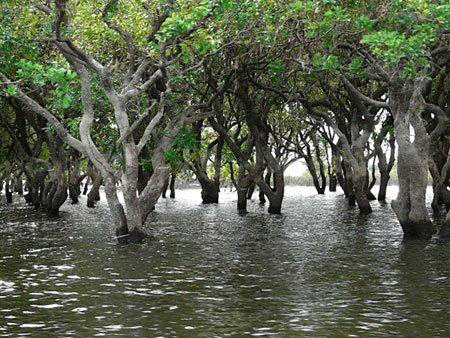(VOVWORLD) - Mangrove forest co-management along the coast is a model people in Au Tho B hamlet in Soc Trang province are implementing effectively. Thanks to the support by the German Society for International Cooperation (GIZ), the protective forest there has grown dense, creating a shield for the area.
 More than 3,000 ha of Soc Trang's mangrove coastal forest will be co-managed by local authorities and the Vo Thanh Van Hamlet coastal forest co-management group, which includes more than 750 local residents. (Photo: duanlamnghiep) More than 3,000 ha of Soc Trang's mangrove coastal forest will be co-managed by local authorities and the Vo Thanh Van Hamlet coastal forest co-management group, which includes more than 750 local residents. (Photo: duanlamnghiep) |
Au Tho B hamlet is covered with a green mangrove forest that spreads along 2km of coastline. 20 years ago the area was a scattered alluvial deposit exposed to sea waves which swept away crops and threatened people’s lives.
Thach Soal, head of the mangrove co-management team in the hamlet, said: “At that time, the forest ranger force was sparse, the people were poor, and local authorities paid less attention to the issue. Forests were destroyed and didn’t grow back.”
Many solutions were proposed but the forest has really grown since 2009, when the mangrove co-management model supported by the GIZ was adopted. 240 local households signed up for the project in an area of 110 hectares.
All the participants have lived all their life in the coastal areas and consider the forest under their management their personal property.
Thach Bun Thone, a member of the afforestation team, said participating households are given licenses to use the forest and exploit aquatic resources.
“All families have land for production along the coast. If the forest is destroyed, seawater will encroach and inflict great losses on the residents. This fact has persuaded me to join the mangrove co-management team to help protect the forest,” said Thach Bun Thone.
To enhance the model’s effectiveness, a program was started to raise a species of sea snail called “oc len” under the mangrove forest canopy. The locals value these snails for their profitability and large consumer market.
Thai Dam, a member of the mangrove co-management team in Au Tho B hamlet, said the locals’ standard of living has improved thanks to increased income from the aquatic resources in the forest.
“We can benefit from both natural aquatic resources like snails and freshwater crabs and from ‘oc len’ raised in the forest,” said Thai Dam.
The model is divided into 4 management areas: a protection zone, an internal rehabilitation zone, an external recovery area, and an area for sustainable use. Each zone has a specific function: protecting the habitat of aquatic species to maintain the diversity of the ecosystem, blocking sea waves, reducing coastal erosion, and expanding the protective forest coverage.
Thach Soal said that during the past few years his team has worked closely with the agriculture sector and local authorities to plant more trees and the local forest coverage has been expanded to 370 hectares.
“We can live without any worries about sea encroachment if the forest is dense. The forest which has spread to more than 1 km of coastline is a sea dyke. It is even stronger than a dyke made of concrete. When the forest is developed, there will be a lot of shrimp and fish for team members to catch," he said.
Combining afforestation and forest protection to allow natural resources to be exploited sustainably, the model being applied in Au Tho B hamlet has been extended to other places in the Mekong Delta Region.